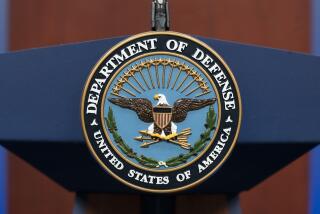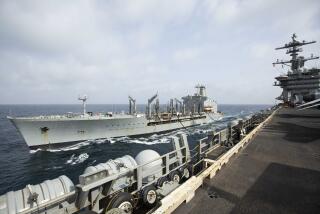Carrier Aims Show of Force at Iraq
- Share via
ABOARD THE USS ABRAHAM LINCOLN — By early afternoon, the sky above the Persian Gulf is so crowded with combat aircraft that it looks like a swarm of flies buzzing in formation. At night, with so many fighter planes aloft, the stars appear to be moving.
The United States and its allies have been building their military might for months as the Bush administration prepares to make good on its threat to punish Iraq for allegedly harboring contraband armaments and weapons of mass destruction.
But raising the massive military fist against Baghdad is also designed to administer a psychological blow. By “projecting force” before any engagement with an enemy, the world’s sole remaining superpower is reminding Iraqi soldiers and civilians of who has overwhelming power. Every flyover, every ship movement, every soldier ferried into the region sends what the Pentagon clearly hopes is a message that it would be futile for Iraq to fight back.
The Lincoln, a nuclear-powered carrier hosting the maiden voyage of the Navy’s new F/A-18E Super Hornet, has been conducting accelerated flights, daily launching nearly 200 sorties that thunder across the flight deck from sunrise to nearly midnight.
“I don’t look at it as trying to send a message. Maybe somebody above my pay grade does. But part of being a successful deterrent is to show force,” said Cmdr. Jeff Penfield, commander of the Super Hornet squadron out of Lemoore Naval Air Station in Southern California. “When you start to see the number of airplanes a single carrier can get airborne in a single day, it shows what’s behind” the threat.
“It’s negotiating with a knife at the throat.”
Asked how much of the recent buildup is aimed at reminding Iraqi President Saddam Hussein of what he faces, Capt. Ron Stites, chief of staff for the eight-ship Lincoln carrier group, replies without hesitation: “All of it.” Like others who have completed multiple missions in this region, Stites insisted that it is time to resolve the protracted standoff with Baghdad.
“We don’t want to come back here. We’d like to end this once and for all and get on to another challenge,” Stites said from the flag deck of this carrier where Rear Adm. John M. Kelly will direct the fighting in a seemingly unavoidable showdown. His sentiments are shared below decks.
“The only thing keeping us going is the cause and purpose of this mission,” said Petty Officer Frank Deehan, who maintains the arresting cables that stop returning fighter jets along a mere 300 feet of the flight deck. “This is my fourth time deploying to deal with Saddam Hussein, and I hope we bring it to closure.”
In some respects, the brandishing of superior force is too much of a good thing. Even now, with three carrier battle groups active in the region -- the Harry S. Truman in the eastern Mediterranean and the Lincoln and Constellation here in the gulf -- the combat choreographers acknowledge that the airspace and sea lanes are getting crowded. At least 19 vessels were visible on the horizon as the planes pounded back to their floating base after sunset.
On the ground, the Army’s 101st Airborne Division, which played a key role in the 1991 Persian Gulf War, was ordered to deploy to the gulf region with its 20,000 troops and 270 helicopters. The number of U.S. military forces in the region now total about 130,000 and is expected to reach 200,000 by early March.
Once three other carrier groups under the Roosevelt, Kitty Hawk and Nimitz arrive, the need to collaborate while staying out of one another’s way will become more of a logistical struggle.
Keeping the fist raised and the threat credible are an evermore demanding challenge for the 5,000-plus sailors and aviators aboard this floating city. The Lincoln already has been at sea beyond its expected six-month deployment, and no relief is in sight until at least the air battles in any U.S.-Iraq war are resolved.
The Lincoln was in Australia, halfway home to its base in Everett, Wash., from a previous gulf mission when word came down on New Year’s Eve that the ship was turning around and heading back to bolster its replacement battle group under the Constellation.
Morale is touch-and-go, as more sacrifices are sought from those who have already sacrificed. Some of the crew members have missed the births of their children. Other offspring have taken first steps with at least one parent missing. Thanksgiving and Christmas were spent away from home. Even spring graduations may be hard to make if the looming conflict drags on.
“I’ll be honest. I want to go home,” said weapons department Chief Obie Loyola, who is eager to see his namesake son, born in December. “But this is what we do for a living. We’re here to liberate Iraq.”
More to Read
Sign up for Essential California
The most important California stories and recommendations in your inbox every morning.
You may occasionally receive promotional content from the Los Angeles Times.











